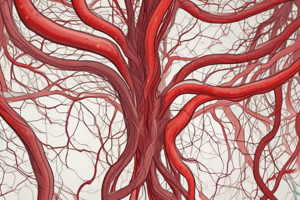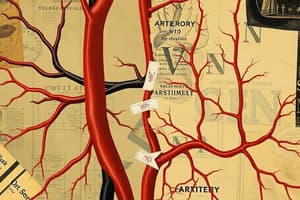Podcast
Questions and Answers
What is the function of the vasa vasorum in blood vessels?
What is the function of the vasa vasorum in blood vessels?
- Supply nutrients to large blood vessels (correct)
- Separate the tunica media from the tunica externa
- Line the tunica intima
- Control contraction and dilation
Where are the nervi vasorum found and what is their function?
Where are the nervi vasorum found and what is their function?
- In the vasa vasorum, supply nutrients to blood vessels
- In the tunica intima, control contraction and dilation (correct)
- In the tunica externa, contain collagenous and elastic fibers
- In tunica media, provide structure and allow stretch
Why do arteries and arterioles have thicker walls compared to veins and venules?
Why do arteries and arterioles have thicker walls compared to veins and venules?
- Thicker tunica externa layer
- Presence of vasa vasorum
- Larger diameter for easier blood flow
- Higher pressure from pumped blood (correct)
Which layer of a blood vessel contains muscles for vasoconstriction and vasodilation?
Which layer of a blood vessel contains muscles for vasoconstriction and vasodilation?
What is the purpose of the internal elastic membrane in large arteries?
What is the purpose of the internal elastic membrane in large arteries?
Where are valves found in blood vessels, and what is their function?
Where are valves found in blood vessels, and what is their function?
What is the driving force that moves blood out of the capillaries and into the tissues?
What is the driving force that moves blood out of the capillaries and into the tissues?
Which hormone is released if blood volume drops, signaling the kidneys to reabsorb water to try to maintain fluid volume and blood pressure?
Which hormone is released if blood volume drops, signaling the kidneys to reabsorb water to try to maintain fluid volume and blood pressure?
What is the primary function of Angiotensin 2 in the body?
What is the primary function of Angiotensin 2 in the body?
What is the role of Atrial natriuretic hormone in the body?
What is the role of Atrial natriuretic hormone in the body?
Which mechanism involves local chemical signaling to open or close precapillary sphincters for perfusion regulation?
Which mechanism involves local chemical signaling to open or close precapillary sphincters for perfusion regulation?
What is the common treatment approach for Hypovolemic shock?
What is the common treatment approach for Hypovolemic shock?
What type of capillary is the most common and forms part of the blood-brain barrier?
What type of capillary is the most common and forms part of the blood-brain barrier?
What is the arterial pressure compared to venous pressure in the body?
What is the arterial pressure compared to venous pressure in the body?
Which vessel has shunts or valves to prevent backflow due to low pressure or gravity?
Which vessel has shunts or valves to prevent backflow due to low pressure or gravity?
What condition is characterized by insufficient blood flow and is often accompanied by hypoxia?
What condition is characterized by insufficient blood flow and is often accompanied by hypoxia?
Which part of the blood pressure reading represents the pressure during ventricular relaxation?
Which part of the blood pressure reading represents the pressure during ventricular relaxation?
What is the formula for calculating Mean Arterial Pressure (MAP)?
What is the formula for calculating Mean Arterial Pressure (MAP)?
Which vessels have smooth muscle sphincters that regulate blood flow to capillary beds?
Which vessels have smooth muscle sphincters that regulate blood flow to capillary beds?
'Pulse' refers to the expansion and contraction of which component?
'Pulse' refers to the expansion and contraction of which component?
'Hypovolemia' refers to a condition characterized by:
'Hypovolemia' refers to a condition characterized by:
'Viscosity' in the context of blood refers to:
'Viscosity' in the context of blood refers to:




